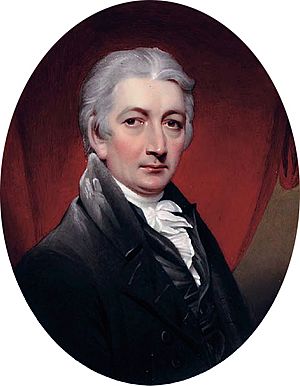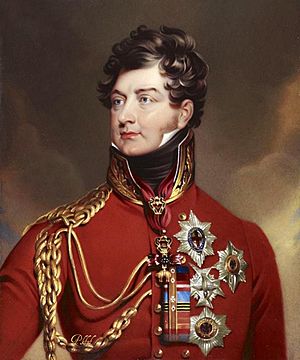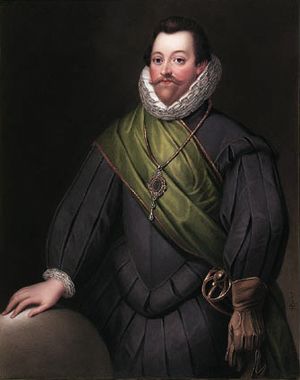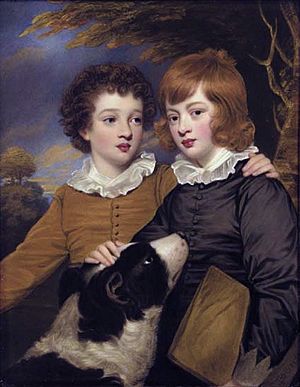Henry Bone facts for kids
Quick facts for kids
Henry Bone
|
|
|---|---|

Portrait of Henry Bone by his son Henry Pierce Bone
|
|
| Born | 6 February 1755 |
| Died | 17 December 1834 (aged 79) |
| Nationality | British |
| Known for | oil portraits; enamel |
| Spouse(s) | Elizabeth Vandermeulen |
| Patron(s) | |
Henry Bone (born February 6, 1755 – died December 17, 1834) was a famous English artist. He was known for his amazing enamel paintings. Enamel painting uses powdered glass melted onto metal to create a shiny, durable picture.
By the 1790s, Henry Bone became very popular. He started painting for the royal family. He continued to be a royal painter for three kings: George III, George IV, and William IV. Early in his career, he also painted on porcelain and jewelry. He became a member of the Royal Academy, which is a big honor for artists. He even made some of the largest enamel paintings ever seen at that time.
Contents
Life and Work of Henry Bone
Henry Bone was born in Truro, a town in Cornwall, England. His father was a very skilled cabinet maker and carver. In 1767, Henry's family moved to Plymouth. There, in 1771, Henry began learning from William Cookworthy. Cookworthy started the first factory in England to make a special type of porcelain.
In 1772, Henry moved with his teacher to a china factory in Bristol. He worked there for six years, from early morning until evening. At night, he studied drawing. His china decorations were very good.
Moving to London and Marriage
When the Bristol factory closed in 1778, Henry moved to London. He had very little money. He first found work decorating watches and fans with enamel. Later, he started making enamel and watercolor portraits.
On January 24, 1780, Henry married Elizabeth Vandermeulen. She was related to a famous battle painter. Henry and Elizabeth had twelve children, and ten of them lived. In the same year, he showed his first painting at the Royal Academy. It was a portrait of his wife, and it was a very large enamel painting for that time. After this, he focused completely on enamel painting. He often showed his work at the Royal Academy.
Royal Appointments and Big Paintings
In 1789, Henry Bone showed "A Muse and Cupid." This was the biggest enamel painting ever made up to that point. In 1800, he became the enamel painter for the Prince of Wales. A year later, in 1801, he became an associate of the Royal Academy. He was also appointed enamel painter to George III. He kept this important job during the reigns of George IV and William IV.
On April 15, 1811, he became a full member of the Royal Academy. Soon after, he created an even larger enamel painting. It was based on a famous painting by Titian called Bacchus and Ariadne. More than 4,000 people came to Henry's house to see this amazing artwork. The painting was sold for a lot of money. Henry cashed the check just in time, as the bank had problems the very next day!
Later Life and Challenges
Henry Bone also created a series of historical portraits. These included portraits from the time of Elizabeth I and a series of "Cavaliers" from the English Civil War. He also painted portraits of the Russell family. However, the Elizabethan series did not make him much money.
In 1831, Henry's eyesight started to fail. He had to move to a new home and sadly accepted a pension from the Royal Academy. He passed away on December 17, 1834. People said he was a kind and generous person.
Henry Bone's Legacy
Before he died, Henry Bone offered his large collection of artworks to the country. The collection was worth a lot, but his offer was not accepted. After his death, his artworks were sold at auctions.
Henry Bone is often called the "Prince of Enamelers." This shows how highly people thought of his skill. A large list of his works, including over 1,000 pieces by Henry Bone himself, was published in 1880.
Family Life
Henry Bone had several children who also became artists. Two of his sons, Henry Pierce Bone and Robert Trewick Bone, also became famous enamel painters. Another son, Thomas, was a midshipman who drowned in a shipwreck. His son Peter was a soldier who was wounded in battle and died soon after. Another son became a lawyer.
Images for kids







